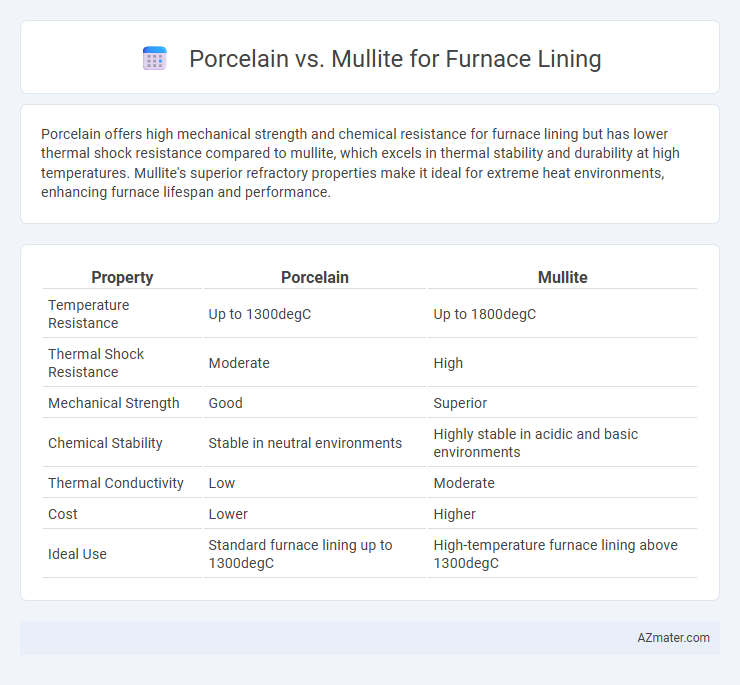Porcelain offers high mechanical strength and chemical resistance for furnace lining but has lower thermal shock resistance compared to mullite, which excels in thermal stability and durability at high temperatures. Mullite's superior refractory properties make it ideal for extreme heat environments, enhancing furnace lifespan and performance.
Table of Comparison
| Property | Porcelain | Mullite |
|---|---|---|
| Temperature Resistance | Up to 1300degC | Up to 1800degC |
| Thermal Shock Resistance | Moderate | High |
| Mechanical Strength | Good | Superior |
| Chemical Stability | Stable in neutral environments | Highly stable in acidic and basic environments |
| Thermal Conductivity | Low | Moderate |
| Cost | Lower | Higher |
| Ideal Use | Standard furnace lining up to 1300degC | High-temperature furnace lining above 1300degC |
Introduction to Furnace Lining Materials
Porcelain and mullite are two common furnace lining materials, each offering distinct thermal and mechanical properties essential for high-temperature applications. Porcelain provides excellent chemical resistance and low thermal conductivity, making it suitable for moderate thermal environments, while mullite exhibits superior thermal shock resistance and high melting points, ideal for extreme temperature conditions. The choice between porcelain and mullite depends on specific furnace operating temperatures, chemical exposure, and mechanical stress requirements.
Understanding Porcelain: Composition and Properties
Porcelain used in furnace linings primarily consists of kaolin, feldspar, and quartz, offering high mechanical strength and excellent thermal shock resistance. Its low porosity and high alumina content contribute to superior chemical stability and reduced slag infiltration during high-temperature operations. These properties make porcelain an effective refractory material for furnaces requiring durable, heat-resistant linings.
Exploring Mullite: Structure and Characteristics
Mullite, a key refractory material for furnace linings, features a stable crystalline structure composed primarily of 3Al2O3*2SiO2, offering superior thermal shock resistance and low thermal conductivity compared to porcelain. Its unique needle-like crystal formation enhances mechanical strength, making it capable of withstanding high temperatures exceeding 1750degC without deformation. Mullite's chemical inertness and durability under aggressive thermal cycling conditions position it as a preferred material for advanced industrial furnace applications.
Thermal Resistance: Porcelain vs Mullite
Mullite exhibits superior thermal resistance compared to porcelain, withstanding temperatures up to 1800degC, making it ideal for high-temperature furnace linings. Porcelain, while durable and cost-effective, typically resists temperatures up to 1400degC, limiting its use in more extreme thermal environments. The high silica and alumina content in mullite contributes to its enhanced ability to maintain structural integrity under intense heat and thermal cycling.
Mechanical Strength Comparison
Porcelain furnace linings exhibit moderate mechanical strength with good resistance to thermal shock but lower durability under high load conditions. Mullite furnace linings offer superior mechanical strength due to their high-temperature stability and excellent thermal expansion compatibility, making them ideal for heavy-duty industrial applications. The dense microstructure of mullite significantly enhances its wear resistance and longevity compared to the more brittle porcelain lining.
Chemical Stability and Corrosion Resistance
Porcelain and mullite exhibit distinct advantages in furnace lining, with mullite offering superior chemical stability due to its ability to withstand high temperatures above 1700degC without significant structural degradation. Mullite's corrosion resistance is enhanced by its low thermal expansion and excellent resistance to alkalis and slags, making it ideal for harsh furnace environments. Porcelain, while chemically stable under moderate conditions, tends to exhibit lower resistance to thermal shock and chemical attack from aggressive molten materials, limiting its use in more extreme industrial settings.
Cost Efficiency and Availability
Porcelain offers a lower initial cost and high availability for furnace linings, making it a budget-friendly choice for many applications. Mullite, while more expensive, provides superior thermal stability and resistance to thermal shock, reducing maintenance expenses over time. The balance between upfront investment and long-term durability determines cost efficiency based on specific furnace operating conditions.
Longevity and Maintenance Requirements
Porcelain furnace linings offer excellent chemical resistance but tend to be brittle, leading to frequent maintenance and shorter longevity under high thermal stress. Mullite, a high-purity alumino-silicate mineral, provides superior thermal shock resistance and structural stability, significantly extending furnace lining lifespan while reducing maintenance needs. Mullite's enhanced durability and lower degradation rate make it the preferred material for industrial furnace environments demanding long-term performance.
Application Suitability in Industrial Furnaces
Porcelain offers excellent thermal insulation and chemical resistance, making it suitable for low to medium temperature furnace linings in industries such as ceramics and glass manufacturing. Mullite, characterized by superior high-temperature stability and mechanical strength, is ideal for high-temperature industrial furnace linings used in metal processing and chemical production. Selecting between porcelain and mullite depends on operational temperatures and the furnace atmosphere, with mullite preferred for extreme conditions requiring durability and thermal shock resistance.
Choosing the Right Material: Porcelain or Mullite?
Porcelain and mullite differ significantly in their thermal stability and mechanical strength, essential factors for furnace lining performance. Mullite offers superior resistance to thermal shock and higher melting points above 1830degC, making it ideal for high-temperature industrial applications, whereas porcelain, with its excellent chemical resistance and lower thermal conductivity, suits moderate temperature settings below 1300degC. Selecting between porcelain and mullite depends on operational temperatures, chemical exposure, and durability requirements in furnace environments to ensure optimal lining longevity and efficiency.

Infographic: Porcelain vs Mullite for Furnace lining
 azmater.com
azmater.com